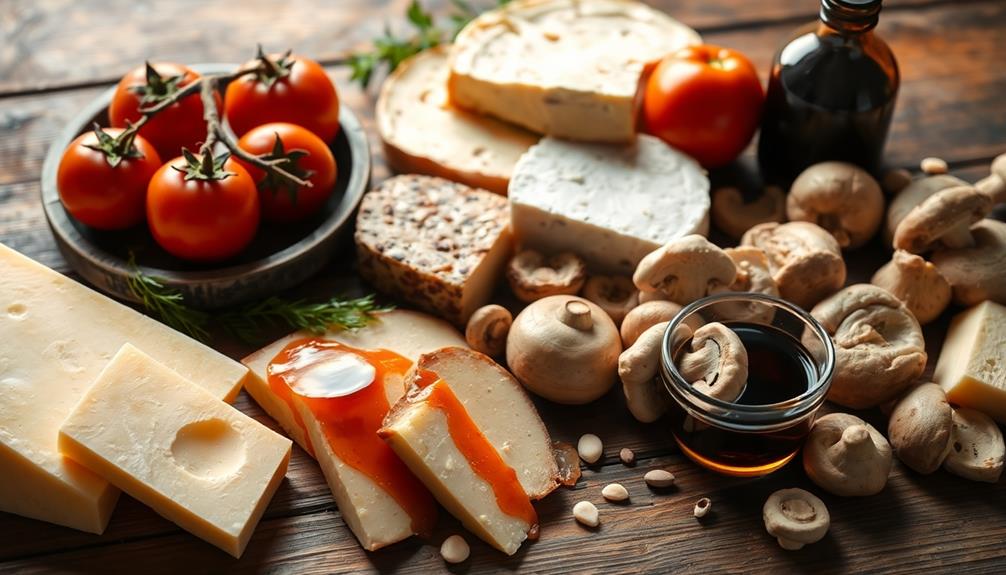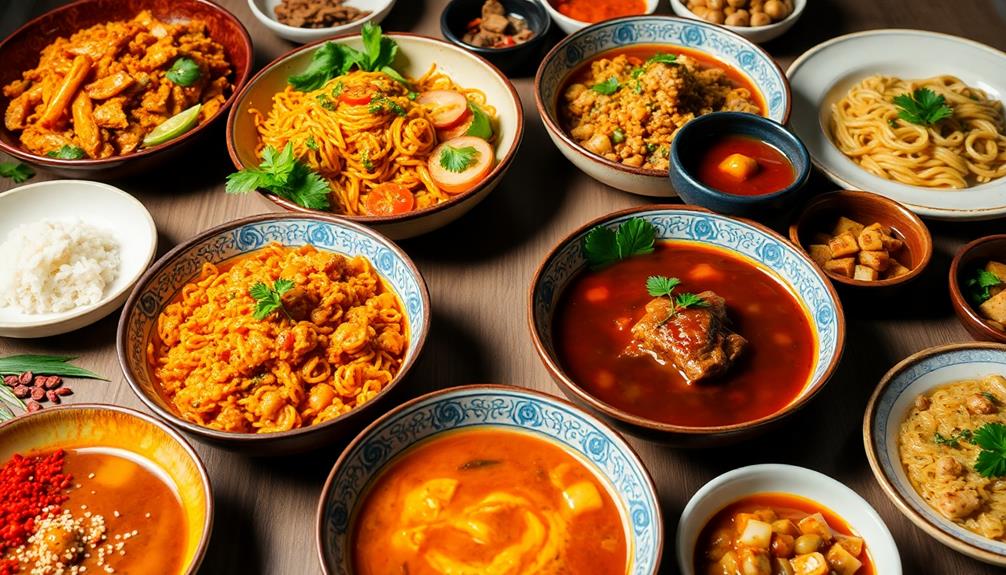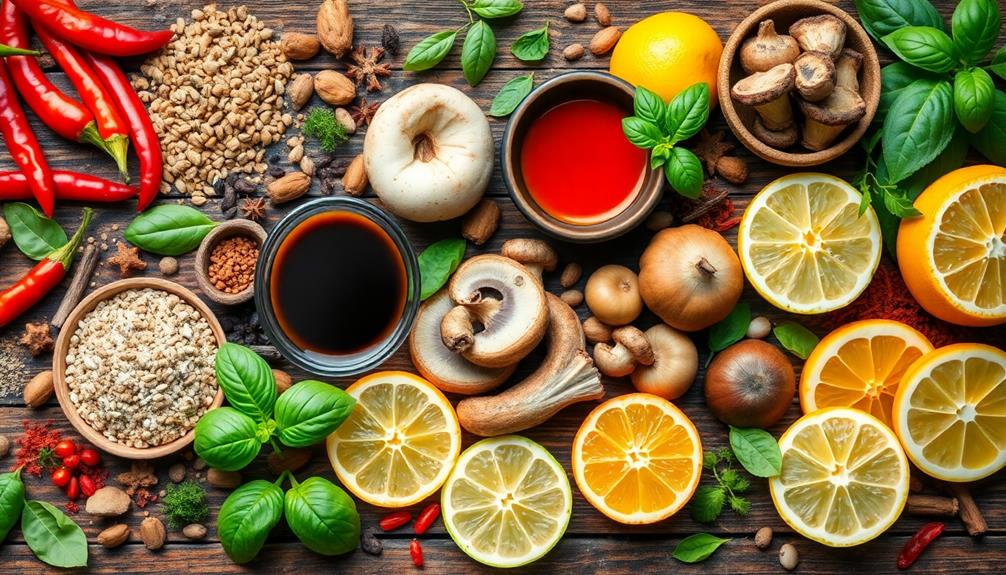Flavor enhancers have transformed global cuisines throughout history. You might be surprised to learn that ancient cultures used fermented fish sauces like garum in Rome and rich spices traded along the Silk Road. Fast forward to the 20th century, umami became recognized as the fifth taste, thanks to Japanese innovations like dashi and MSG. While some embrace natural enhancers like herbs, others lean toward synthetic options. Each approach greatly impacts flavor profiles and cross-cultural dining experiences. If you're curious about how these traditions and innovations have evolved, there's so much more to explore.
Key Takeaways
- Ancient civilizations utilized flavor enhancers like fermented fish sauce and aromatic herbs, laying the foundation for modern culinary practices.
- The Silk Road facilitated the exchange of spices and herbs, enriching diverse global cuisines and influencing flavor enhancement techniques.
- Umami, recognized as the fifth basic taste in 1908, transformed culinary approaches, particularly in Japanese cuisine with dishes like dashi and Hiyashi Chuka.
- MSG, isolated in 1908, became a revolutionary flavor enhancer, gaining popularity in various cuisines and reshaping taste experiences worldwide.
- Cultural perceptions of flavor enhancers vary globally, with natural options often valued more than synthetic counterparts, highlighting the importance of flavor science.
Ancient Practices of Flavor Enhancement

Throughout history, ancient civilizations have harnessed the power of flavor enhancement to elevate their culinary creations. You'd find that fermented fish sauce, like garum in Rome, served as a key flavor enhancer, packed with umami compounds that transformed the taste of various dishes.
The Silk Road played an essential role in this journey, facilitating the exchange of spices and herbs, allowing cultures to infuse their cuisines with exotic flavors from distant lands. In Chinese cuisine, for instance, dishes like Red-Braised Pork Belly demonstrate the rich flavors achieved through slow braising in soy sauce and spices.
In Asia, the tradition of using soy sauce—another fermented product rich in umami—dates back over 2,500 years, showcasing the long-standing commitment to flavor enhancement in culinary practices.
Meanwhile, ancient Egyptians relied on aromatic herbs and spices like cumin and coriander, demonstrating early techniques for enhancing food flavors.
Moreover, the practice of drying and fermenting food to develop deeper flavors wasn't limited to one region; it spread across multiple ancient cultures, reflecting a global understanding of flavor enhancement.
These methods laid the foundation for modern culinary practices, reminding us that the quest for deliciousness has always been integral to human experience.
The Rise of Umami

Umami has become a culinary sensation, enchanting chefs and food enthusiasts alike with its rich, savory allure. This umami taste, identified as the fifth basic taste by Professor Kikunae Ikeda in 1908, stems from the isolation of glutamate found in kombu. Ikeda's discovery established a distinct flavor profile that complements the traditional tastes of sweet, sour, salty, and bitter.
In Japanese cuisine, umami is prominently featured in dishes such as Hiyashi Chuka (Cold Ramen), which showcases a delightful combination of flavors that embody this savory essence.
The term "umami" translates to "pleasant savory taste," and its influence has spread globally since the 1980s. You'll find it enhancing dishes across various cuisines, as chefs embrace this flavor enhancer.
Umami is linked to protein content, signaling nutritional value, which makes it even more appealing in culinary practices. Ingredients rich in glutamate, inosinate from meat, and guanylate from mushrooms work together to create flavorful masterpieces.
Japanese dashi, combining kombu and bonito, showcases the synergy of umami-rich components, emphasizing its importance worldwide.
As you explore culinary landscapes, you'll discover how umami enhances not just taste but also the overall dining experience, making every meal a rich adventure in flavor.
The Role of MSG

Monosodium glutamate (MSG) has become a cornerstone in the culinary world, celebrated for its ability to amplify flavors and enrich dishes.
Originating from glutamic acid, an amino acid found in various foods, MSG enhances the umami flavor that many crave. In many cultures, such as in Brazilian cuisine, unique ingredients and techniques create rich flavors, often complemented by MSG.
When you're eating at Chinese restaurants or enjoying processed foods, MSG is often the magic ingredient boosting taste.
Here are some key points about MSG:
- First isolated in 1908 by Professor Kikunae Ikeda from kombu seaweed.
- Commercialized in 1909 by the Ajinomoto company, quickly spreading through Japan and beyond.
- Gained traction in the U.S. during the 1920s, becoming synonymous with Chinese cuisine.
- Classified as generally recognized as safe (GRAS) by the FDA, WHO, and others.
- Nowadays, it's frequently used in fast food and snacks, reflecting a shift in culinary practices.
In the food industry, MSG plays a crucial role in creating more satisfying flavors.
As the stigma fades, don't shy away from enjoying dishes enhanced with MSG—it's a reliable way to elevate your dining experience!
Natural vs. Synthetic Flavor Enhancers

In today's culinary landscape, the choice between natural and synthetic flavor enhancers can greatly impact your cooking and dining experiences. Natural flavor enhancers, like monosodium glutamate (MSG), come from real ingredients such as herbs, spices, and fruits. They provide a unique taste that reflects the authenticity of global cuisines.
On the other hand, synthetic flavor enhancers are chemically manufactured to mimic these natural compounds, ensuring flavor consistency and a longer shelf life.
While MSG, derived from glutamic acid, is a standout among natural enhancers, synthetic options, like artificial vanilla, are commonly used in modern food production due to their cost-effectiveness.
The spice trade historically highlighted the value of natural flavors, fueling exploration and cultural exchange. However, advancements in biotechnology have led to bioengineered natural flavors that aim to capture traditional complexity, although they may not fully replicate the authentic taste of their natural sources.
As the debate between natural and synthetic continues, emerging flavor technologies promise to merge the benefits of both approaches, enhancing your culinary experiences while promoting sustainability.
Whether you prefer the authenticity of natural flavors or the reliability of synthetic ones, your choice shapes your meals.
Cultural Impact of Flavor Enhancers

Flavor enhancers have woven themselves into the fabric of culinary traditions around the world, shaping how we experience taste and culture. Their historical presence, from ancient Roman garum to Japanese dashi, highlights the long-standing appreciation for umami flavor.
Monosodium glutamate (MSG) revolutionized flavor enhancement in the early 20th century, leading to its widespread use in both Asian and Western cuisines.
However, cultural perceptions of flavor enhancers can differ greatly. Despite MSG being recognized as safe by health authorities like the FDA and WHO, skepticism persists, particularly in Western countries. This misunderstanding often overshadows the rich culinary practices that utilize these enhancers.
Consider the impact of flavor enhancers on global cuisines:
- They deepen flavor profiles, making dishes more appealing.
- They foster cross-cultural culinary exchanges, integrating diverse ingredients.
- They elevate traditional recipes by enhancing umami flavor.
- They contribute to modern cooking styles, adapting ancient practices.
- They challenge misconceptions, promoting a better understanding of flavor science.
Ultimately, flavor enhancers not only transform individual dishes but also bridge gaps between cultures, enriching our global culinary experience.
Frequently Asked Questions
What Is the History of Flavouring?
Flavoring's history dates back to ancient times, when spices and herbs were traded. You'll find that over centuries, cultures innovated with fermented products and eventually embraced synthetic options, shaping the culinary landscape we enjoy today.
What Is the History of MSG in Food?
MSG's journey began in 1908 when it was isolated from kombu. You might notice its flavors enhancing dishes in restaurants, especially Chinese, and despite past concerns, it's now widely recognized as safe and flavorful.
Who Discovered the Umami Sense of Taste?
You can credit Professor Kikunae Ikeda for discovering the umami taste in 1908. He isolated glutamate from kombu, recognizing it as a distinct flavor that enhances other foods, enriching culinary experiences around the world.
What Is the Most Recently Recognized Flavor in the World?
You know what they say: "Good things come to those who wait." Recently, researchers recognized kokumi as a flavor, enhancing the perception of richness and mouthfeel in food, adding depth beyond the traditional five basic tastes.
Conclusion
Flavor enhancers have shaped cuisines worldwide, proving that they're not just modern conveniences but integral to culinary tradition. While some might argue that they compromise authenticity, consider this: many beloved dishes rely on these enhancers to achieve their signature tastes. Embracing flavor enhancers doesn't mean sacrificing tradition; it's about enhancing the experience. So next time you savor a dish, remember the rich history behind those flavors and how they've evolved to delight your palate.









